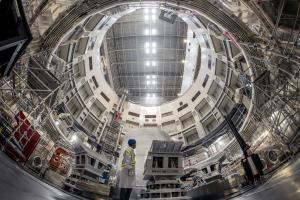Cryostat base and lower cylinder are now one
The first in-pit welding operation—the welding of the lower cylinder to the cryostat base—began in October 2020 and lasted six months, including testing. Like all previous cryostat welding operations, it was performed by India's contractor MAN Energy Solutions (sub-contractor of cryostat segment manufacturer Larsen & Toubro).
Following a first phase of root welding by way of a technique known as "double operator" welding (one working from the inside, the other from the outside), nine specialists continued working simultaneously on the 90 metres of circumference, using more than 1.5 tonnes of filler material in the process.
Distortion monitoring was performed on a regular basis by way of 50 metrology targets distributed on the inner surface of the components. "Because of the heat that the welds generate, deformation inevitably occurs, but we have ways to minimize that. Margins are included by manufacturing design and throughout this six-month operation we were never outside tolerance," says Vikas Dube, a mechanical engineer in ITER In-Cryostat, Cryostat Thermal Shield, Auxiliaries Section.
A weld, however, is not considered final until it is tested. Beginning with visual inspection, the non-destructive examination process implements a series of tests ranging from the simple, like dye penetrant test examination, to the ultra-sophisticated like helium leak tests.
The final check consists of a dimensional inspection that compares the data from the welded components to the data that was recorded before the start of welding, as well as to the requirements from the manufacturing drawings. There again, "everything was within the limits," says Vikas.


